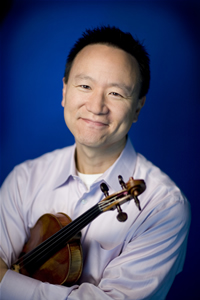The Brevard Philharmonic under the direction of Donald Portnoy opened its 36th season in the beautiful Porter Center for the Performing Arts at Brevard College with this concert of “two Bs.” David Kim, concertmaster of the Philadelphia Orchestra, was the soloist for Max Bruch’s Violin Concerto No. 1 in G minor, Op. 26. Beethoven’s Symphony No. 2 in D, Op. 36 was performed just before intermission, and Mozart’s Overture to The Marriage of Figaro, K. 492 was first on the program. This performance was sponsored in memory of Ann Bryant Pickelsimer by members of her family.
Mr. Kim grew up in Pennsylvania and South Carolina, and earned his bachelor’s and master’s degrees from The Juilliard School. Prior to becoming the concertmaster of the Philadelphia Orchestra in 1999, he enjoyed a career as a touring soloist and still concertizes as both a soloist and a chamber musician. In 1986 he was the only American violinist to win a prize at the International Tchaikovsky Competition in Moscow. He has been associated with Portnoy for over 20 years, having performed multiple times with the University of South Carolina Symphony Orchestra which Portnoy conducts. He performs on a 1757 J.B. Guadagnini violin on loan from the Philadelphia Orchestra.
The orchestra gave a very credible performance of the Overture to Mozart’s comic masterpiece which crackled with sustained energy and humor throughout. Unfortunately I had been seated way off to the side behind the violin section and was unable to hear much else, so I quickly scooted to the back of the hall for the remainder of the program.
The Beethoven Symphony No. 2 followed immediately and the juxtaposition of these two works, written approximately 25 years apart, afforded an interesting comparison. Beethoven composed the symphony in 1801-1802 during a period of both feverish creativity and personal crisis as he dealt with his loss of hearing. Composing was for him a refuge from the tumult of his life and within this score one can hear a gamut of moods — jubilation, humor, and dramatic intensity. Beethoven’s biographer Maynard Solomon has labeled the style of this symphony “both retrospective and prospective” — retrospective in the orchestra’s size and in its 4-movement formal design, and prospective in the musical content unique to the composer. It’s no wonder that critics found the piece baffling. The orchestra’s performance of the first movement (famous for its lengthy slow introduction) was gratifying for its emotional scope, intensity, and balance among the sections. The extensive and beautiful second slow movement was a high point of the afternoon, where the warmth of the string section and cohesiveness of the wind choir were especially noteworthy. The third movement scherzo was rather flat in affect and seemed to lack any rhythmic vitality, as though the orchestra hadn’t quite shaken off the serenity of the preceding movement. Likewise, the fourth movement “Allegro energico” begged for more to be made of its titanic peaks and valleys, and the audience evidently thought so, too, and responded with a desultory and rather disappointed round of applause.
Without a doubt the Bruch concerto was the highlight of the afternoon. Bruch finished composing the concerto in 1866, and then revised it according to the advice of violinist Joseph Joachim who first performed it in 1867. Joachim later highly praised the work, calling it “the richest and most enchanting” of the nineteenth century’s four great violin concerti. It has a sort of Mendelssohnian tunefulness coupled with virtuosic demands, all bundled within a three-movement concerto form that deviates from formal conventions in intriguing ways. Kim is a brilliant performer with a great understanding of stylistic nuance. He plays with an elegant economy of motion, and never resorts to the histrionics of large gestures seen so frequently on stage. In fact, I believe he inspired the best playing of the afternoon from the orchestra that appeared to be actively listening to his tempi, dynamics, and articulations. Portnoy kept the balance between the soloist and orchestra finely monitored so that all could be clearly heard. The excitement generated from this performance brought whoops of approbation and a standing ovation.











